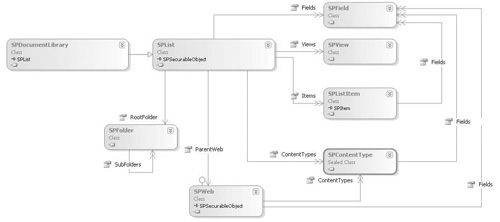We’ve looked at how content within
SharePoint is defined using content types, columns, and field types.
The next element to consider is how the content is stored within the
SharePoint data store. That brings us to lists and document libraries.
Lists and document libraries don’t physically exist.
There is a perception that data stored in lists and libraries is slow
to use because it exists in a file structure as opposed to a relational
database, but this is not the case. All content managed by SharePoint
lives in a relational database. Having said that, the highly abstracted
nature of the data structure doesn’t lend itself to high performance
data access, and as you’ll see later, there are other means of
achieving this goal if it’s critical to your application design. Behind
the scenes, all user data is actually stored in a single table in the
content database.
SharePoint offers two types of content containers:
lists and document libraries. The difference between these two is in
the types of content that they can contain. Lists can contain only
content that is not derived from the document content type, and
document libraries can contain only content that is derived from the
document content type.
From an object model perspective, a document library
is a specialized form of a list. This is an important point, because
the SPList object and its properties are the starting point for much of
the custom code that we’ll write for the SharePoint platform.

This class diagram highlights an interesting point
that we haven’t discussed so far: how columns and content types are
related to lists and document libraries. You’ve seen how a content type
can contain references to reusable columns, and you should understand
how these content types can be used by lists and libraries to define
the types of content that may be stored. However, from the class
diagram, you can see that the SPList class has a Fields collection as
well as a ContentTypes collection. From the diagram, you can also see
that the SPWeb object has a Fields collection and a ContentTypes
collection.
When
we create content types or add new columns using the user interface,
these columns are defined at the site level (which the object model
confusingly represents using the SPWeb object). These columns are known
as site columns and we can see this
terminology used in the user interface and throughout the
documentation. The same is also true for content types: when we create
them using the user interface, they are known as site content types.
If we assign a content type to a list or library,
SharePoint behind the scenes creates a new content type that inherits
from our Site content type. This new content type is known as a List content type.
Generally speaking, the ContentTypes collection of the SPList object
will contain List content types. List content types and list columns
can be freely changed at the list or document library level without
affecting other instances of the associated site content type or column
that are in use elsewhere.
As mentioned, columns exist independently of content
types. A content type simply references the columns that it uses. As a
result of this, when multiple content types are added to a list or
library, the Fields collection of the associated SPList object contains
an amalgamation of all the fields that are required. However, as well
as the fields that are required by associated list content types, you
can also add arbitrary fields to a list that are not associated with
any content type.
Views
As we’ve seen from the class diagram, the SPList
object has a collection of SPView objects. This raises the question,
What is an SPView and how does it relate to lists and libraries? An
SPView object represents the definition of a view on data contained
within an SPList. In much the same way as an SQL view is ultimately an
SQL statement that specifies the columns to select and any filters or
sorting conditions, an SPView represents a query that selects values to
be displayed from a SharePoint list together with any additional
formatting parameters.
Queries
Data contained within SharePoint lists and libraries can be queried in a few ways.
Fundamentally, the SharePoint platform provides its
own query language in the form of Collaborative Application Markup
Language (CAML). As mentioned, one of the design goals of SharePoint
was to create a platform that allowed nontechnical users to define data
structures easily. As a consequence of this requirement, the underlying
database schema does not lend itself to executing user-generated SQL
queries. In fact, direct access to the underlying database is strongly
discouraged and is not supported by Microsoft. Since executing standard
SQL statements is not an option, Microsoft introduced CAML as a
SharePoint-specific query language. Behind the scenes, the SharePoint
platform converts CAML queries into valid SQL that extracts the
required data from the underlying database schema, hiding the
complexity of the schema from users.
Here’s an example of a CAML query:
<Query>
<Where>
<And>
<Contains>
<FieldRef Name='Title' />
<Value Type='Text'>abc</Value>
</Contains>
<Lt>
<FieldRef Name='FileSizeDisplay' />
<Value Type=‘Computed’>50</Value>
</Lt>
</And>
</Where>
<OrderBy>
<FieldRef Name=‘Created’ Ascending='False' />
</OrderBy>
</Query>